Angel pew end in Trunch church, Norfolk, January 2023.
Wonderful what will come out of darkness:
stars, owl voices, sleep;
water, green shoots, birds’ eggs
with their own curved darkness;
gemstones; a whole and perfect child
from my unseen recesses; delight
from behind shut lids, finding each other,
fingers and tongues made delicate by night.
Great magic’s performed after sunset.
Old alchemists conjuring angels,
witches dancing spirals under the moon;
drum-shamans, their spirit journeys;
three nights in a tomb
staging a resurrection. Transformations
taking place out of ordinary sight.
Daylight gives us boundaries, fixes
everything. The world separates
into colours and chemicals, figures
and faces. Surfaces appear solid
reliable, unconfused. We can see
to operate complex machinery.
Only darkness permits mixing
of elements, stirring of essences
in secret, combing dark and bright
into new patterns while we sleep; so dawn
finds us transformed, shifted.
Star particles link us with trees
dolphins and stones, travel through us
Creating the universe. Base matter
becomes gold: in the Cauldron
of Annwn, in the crucible of mind
we’re all magicians. The Hidden Stone,
Elixir of Life, eludes us; we’ve lost
the art of working through touch
with invisible forces: but as darkness
rises, and we grope wildly, perhaps
out of chaos the magic will come right.
Hilary Llewellyn-Williams, ‘Alchemy’, Book of Shadows
Hello, and welcome to the Bracken & Wrack newsletter for this full Wolf Moon.
January has been a strange month, tricksy and hard to pin down in terms of the feeling of the season, slippery even in a literal sense during a recent icy snap. Over the past couple of days here in my little corner of north Norfolk there have been very blustery winds but also a new brightness, perhaps, as if we are beginning to come out of the darkness and into the clear airs of spring. I can’t decide whether I am ready yet to emerge blinking into the day from the warmth of my nest despite some beautiful forays into the wintry countryside between the heath and the sea. I have a feeling that the imminent arrival of Candlemas or the Feast of Brigid also known as Imbolc will be a game changer and that lovely Bridie will soon be among us, sweeping our hearths clean and preparing us to take our next steps with her gifts of the three flames of poetry, creativity and healing.
Meanwhile, this time a theme seems to have emerged that is less about nature’s seasonal shift and more about the liminal space between the dark and the light where, even now, seeds are stirring.
In this edition:
Poetry by Hilary Llewellyn-Williams and John Clare
Orion the Hunter
A Raw and Magical Realm
Witches on Sheep Trays
Soothing the Storm
The Wisewoman’s All-Purpose Spell Cakes
ORION THE HUNTER
… familiarity with the stars begins to open the door upon a very beautiful awareness of our Earth as a member of the holistic universe. It does not lead to a feeling of individual insignificance and loneliness, but to a consciousness which banishes feelings of isolation.
Claire Nahmad, Earth Magic
It is a great and beautiful thing to stand beneath [Orion] on a clear night and gaze up with awe at its mighty stars, feeling the pull of the wild energies as it leads you on an ecstatic chase that can last half the night.
Nigel G Pearson, Walking the Tides
And so we begin our new full moon series on the constellations with one of the most familiar sights in the night sky - Orion the Hunter.
Here in the Northern Hemisphere it’s winter; the perfect time to appreciate the stars when the firmament sparkles over our heads on a fresh, dark, cold night. It’s true to say though if you live in a built up area you will inevitably be contending with light pollution. Even though my cottage is about as rural as you can get, the enormous gas terminal a couple of miles away definitely has an effect on the skies in that direction. Unless you are very lucky you may well have to move yourself to a good star-gazing spot in order to truly connect with the constellations in all their glory, and thus begin to understand their relationships one to another. Perhaps you already have a practice of doing that, or you may like to start your own ritual of choosing a clear night once a month (or more) to visit a special place close to your own home.
It’s strange that I have chosen to to make this a full moon series when actually the days around the full moon are the worst ones to really get a clear view of the stars! The brilliance of the moon tends to dull the appearance of nearly every constellation and render their tiny pinpricks of light invisible, especially the subtle ones like Cancer the Crab whose gleam is faint. It’s worth remembering that the stars are always in their positions whether or not we can see them clearly, and that their magic is available to us whichever hemisphere we live in. If you intend to keep up a practice throughout the year in a place you have bonded with, I would suggest circling the days around each new moon for your observations if you can.
You might like to start a star journal for your thoughts and findings, adding in any notable experiences you have when stargazing, together with stories or myths you may discover that are traditional to other cultures. And of course your own stories or poems inspired by the constellations that amazingly, magically, wheel across the sky night after night.
Whether or not you prefer to limit your stargazing to what you can see with the naked eye, take the half-way house approach and view through binoculars or go for a full telescope set-up is a matter of personal choice. I tend to use my own eyes only, although perhaps one day I will remember to try out my binoculars. But truth to tell I like connecting with the stars face to face as our distant ancestors did.
So, let’s take a closer look at the powerful and majestic form of Orion as he rises in the east and sets almost due west during the winter months. Up and up he sails behind the big oak tree in front of my bedroom window. At first his stars illuminate the spaces between the bare branches like fairy lights before breaking free in brilliant splendour and striding over the cottage roof.
Sunrise: Last night Orion ascended this oak tree and leapt across the cottage roof.
Orion’s four brightest stars form a quadrilateral, in the midst of which are three other stars almost as radiant, slanting downwards. The brightest star at the top left-hand corner of the quadrilateral is Alpha Orionis or Betelgeux, which means Giant’s Shoulder and glows with an ember-red light. Rigel, the star in the lower right-hand corner, glitters with a blue-white radiance and is more vivid than Betelgeux, although it was once less powerful which is why it’s Orion’s second star. Its name means Giant’s Leg.
In the top right-hand corner is Bellatrix (Female Warrior), a hot blue star 3.7 times hotter and nine times more massive than our own sun. The lower left-hand corner is formed by the brilliant blue-white Saiph (Giant’s Sword, although it is shown on star charts marking Orion’s knee).
Orion’s Great Nebula is a cloud-bed of shining cosmic dust, illumined by the radiance of the stars which cluster in it, located in the line of three angled stars that form his belt.
After a long absence from our skies during the summer, Orion returns in October to announce the season of the Wild Hunt which is, as Nigel Jackson puts it: that chaotic race of damned and lost spirits which cross the night sky, pursued by the horses and hounds of the spectral warriors, led by the Lord of the Dead himself.
But what of the legend behind the constellation?
Orion was a giant hunter, beautiful in form and face. Son of the sea-god Poseidon and Euryale a daughter of Minos, King of Crete, through his father’s magic he could walk on the waves. In this way he walked to the island of Chios where, in a drunken state he raped Merope daughter of Oenopion who ruled that kingdom. In vengeance, Oenopion blinded Orion and drove him away.
Orion stumbled to Lemnos where Hephaestus the smith-god had his forge. Hephaestus told his servant, Cedalion, to guide Orion to the Utter East where Helios, the Sun, healed him. Orion returned to Chios to punish Oenopion, but the king had hidden underground and so escaped the Hunter’s wrath.
The giant’s next journey took him to Crete where he hunted with the goddess Artemis and her mother Leto, and in the course of the hunt, threatened to kill every beast on Earth. This so enraged the Earth Mother, Gaia that she sent a giant scorpion to sting and kill Orion. The creature despatched the Hunter, and after his death the goddesses asked Zeus to place Orion among the constellations. Zeus consented and added the Scorpion to the heavens as well. This part of the legend is borne out in the movements of the stars: as the constellation of Scorpius rises in the east, Orion sinks into the west to rest until the cycle turns once more.
In an alternative version of the story, it is Artemis who is tricked into mortally wounding Orion with one of her arrows whilst he is swimming and, in remorse, places him into the heavens for all eternity.
If you prefer to equate the constellations to archetypes within your own land or culture, you are sure to find resonances once you start looking at indigenous stories. For example, Nigel Pearson tells us that Orion has been compared to the Anglo-Saxon mythic figure of Earendel who was a warrior and huntsman, and also to Wayland the Smith.
Next time: Perseus.
January stars in the cottage kitchen.
A RAW AND MAGICAL REALM
My last ‘between the moons’ post was all about a walk down the frozen lane to the alder carr, where I was greeted by a newly-enchanted world of frost and fire.
Frozen alder carr, Crostwight, Norfolk. 19 January 2024.
That piece of writing was all about taking you with me on the walk rather than being an exploration of these wet woodlands known as carrs, so I decided to do some research to try to find out more about them.
I should start by saying that although I always call this little patch of woodland ‘the alder carr’, there are probably just as many birch trees as alders, and a few other kinds of tree as well. Just as long as they don’t mind their feet getting wet. Alders love the damp, and rather than rotting when left submerged in water the wood becomes as hard as stone. People have made good use of this property since the Bronze Age at least, when crannochs - wooden strongholds on Scottish lochs - were built on rafts or piles of alder trunks. But it’s quite a surprise to see how happy the birches are. It makes sense that the Silvery Ones would have evolved to be adaptable though, given that they are pioneer trees and were the first to colonise this land after the last Ice Age.
Down at the carr, you will usually see the flashing movements of small birds darting from tree to tree: blue tits, great tits and goldcrests all year round, with willow warblers, black caps, chiff chaffs and other birds of the summer once the season shifts again. Tree creepers spiral up tree trunks while nuthatches scuttle up and down, often head first. The drumming of woodpeckers reverberates from tree to tree. Squirrels perform acrobatics overhead while above the trees you will often hear rooks and crows before you see them through gaps in the canopy. In autumn and winter, it’s the skeins of wild geese that get you craning your neck until the last straggler in the V has passed beyond view.
The alder carr along the lane in drier conditions.
So what exactly is a carr and why are they special?
I always find patches of wet woodland in valley bottoms very exciting as they give us a glimpse of how much of the low-lying landscape would have looked centuries ago before modern farming practices sought to tidy things up. Streams were deepened and straightened and even moved completely, while grids of ditches or drainage channels and culverted sections often make it difficult to see the natural flow of any watercourse.
Before all of this, a valley bottom would naturally flood and dry out with the seasons, and water would flow where it chose, the deepest hollows being continually made and remade according to the degree of rainfall and snowmelt in any given year. Close to my previous home, a gloriously wild SSSI (site of special scientific interest) called Whitwell Common displayed exactly that phenomenon. It was a joy to explore beyond the prescribed footpaths to areas among the alders where you never knew exactly how the path of the stream would have altered from visit to visit. Sometimes it was easy to jump across and at others you would have to wander along to a place where the waters forked leaving two narrower channels to traverse.
Whitwell Common, Norfolk.
At sunrise I sometimes sat at the base of one of the alders where I could hang my drum case on one of the many whippy shoots that spring up around each trunk and sit with curling incense and my staff stuck into the soft ground, drumming gently and watching the life of the carr unfold. Herons, tiny birds, roe deer, fox musk and once a pair of water voles swimming round and round together.
In another spot, there was almost always a large pool. A huddle of alders had formed a natural temple shape right by the edge where again I often went, usually later in the day, with a flask and a notebook. The bark of a muntjac or the quiet plop of a catkin or bunch of cones landing in the water and breaking the reflections were often the only sounds.
View from the ‘temple’, Whitwell Common, Norfolk.
In the spring the pools between the trees would be a mass of yellow flag iris and I watched the green spears for the weeks beforehand as they pierced the surface and thrust upwards, needle sharp.
Yes, these are special places indeed.
In Irish mythology, when Deirdre of the Sorrows of Irish mythology eloped with Naoise, son of Usna, they fled from Ulster to Scotland to escape the wrath of King Conchobhar mac Nessa to whom Deirdre had been betrothed. They hid from the King’s pursuing warriors in the alder woods of Glen Etibhe, where they eventually settled, and themes of hiding and secrecy connected with alder recur elsewhere in Celtic lore.
Perhaps these themes were derived from the particular atmosphere of alder carrs. Being such mutable and liminal places it’s not surprising that carrs would gain a reputation as being places to be feared. After all, any number of bandits and other beings of ill intent both human and otherwise could be lurking unseen between the trees. The theme of ‘hiding’ can even be seen in the green dye obtained from the flowers and leaves as it could have been used to colour and camouflage the garments of outlaws like Robin Hood. I’ve also read that the fairies use alder to dye their clothes, thus helping to conceal them from human eyes.
Rather more disconcertingly, the peeling bark of the alder shows blood red underneath and when the light falls on these curls in a particular way the red is so vivid it makes you jump.
You might walk down the lane beyond the heath and cross the bridge - always glancing hopefully to either side for a glimpse of kingfisher, otter or heron - and pass the alder carr without pausing to step within. But take the chance, step over the singing wire and come face to face with a raw and magical realm.
WITCHES ON SHEEP TRAYS
If you read Bracken & Wrack you will know that I often draw on the poetry of John Clare for inspiration, especially the Shepherd’s Calendar. This is a vivid and often visceral first hand account of rural life in the nineteenth century, arranged month by month. For January there are two poems, A Winter’s Day and A Cottage Evening. While it’s tempting to choose a section describing the wintry land and its workers, I was very taken with the second poem which describes a family evening around the fire after the day’s work is done. The poem speaks of the way that the lady of the household tells tale upon tale of fairies, witches and supernatural beings, while the rapt children listen, delicious shivers running up their spines.
I found the poem fascinating on many levels. Not only does it give a rare glimpse into a workaday rural household of 200 years ago, but the stories and folklore themselves are very revealing of the country beliefs that clearly hung on from an earlier age. Read the poem yourself to discover more, but here is the part where the children’s bedtime arrives.
Thus dames the winter night regales
Wi wonders never ceasing tales
While in the corner ill at ease
Or crushing tween their fathers knees
The children silent all the while
And een repressed the laugh or smile
Quake wi the ague chills of fear
And tremble while they love to hear
Startling while they the tales recall
At their own shadows on the wall
Till the old clock that strikes unseen
Behind the picture pasted screen
Where Eve and Adam still agree
To rob lifes fatal apple tree
Counts over bed times hour of rest
And bids each be sleep’s fearful guest
She then her half told tales will leave
To finish on tomorrow’s eve
The childern cringe away to bed
And up the ladder softly tread
Scarce daring from their fearful joys
To look behind or make a noise
Nor speak a word but still as sleep
They secret to their pillows creep
And whisper oer in terrors way
The prayers they dare no louder say
And hide their heads beneath the clothes
And try in vain to seek repose
While yet to fancys sleepless eye
Witches on sheep trays gallop bye
And faireys like to rising sparks
Swarm twittering round them in the dark.
John Clare, ‘January: A Cottage Evening’, The Shepherd’s Calendar
Can you see the strange beast that lurks in Acorn Wood?
SOOTHING THE STORM
With the recent flurry of severe storms, I thought we should turn to our Victorian Yorkshire wise-woman to see whether she has any charms up her sleeve to help to placate the January weather-gods.
True to form, she does. And the spell, or rune as she often calls her verses, invokes spiritual beings of all kinds without any perceived boundary between Christian magic, the movements of astral bodies and the enchantments of the fair folk. This is one of the aspects of Claire Nahmad’s transcription of her maternal grandmother’s teachings that struck me immediately and deeply. Her approach is holistic and it appeals to me a lot.
Angels Four we call upon
Of Air and Earth and Moon and Sun
And fairies too we call upon,
Of sky and land and sea and fire,
May fairies give ear to our desire;
Calm the wind, soothe the storm
Let the raindrops cease to form;
To hush the thunder, clear the skies
We chant this rune both good and wise;
And by our Holy Lord and Lady
So mote it be, so mote it be.
(Charm To Turn Away Violent and Dangerous Weather)
Here is another which may come in useful:
Rain, rain, go away,
Come again tomorrow day;
When I brew and when I bake,
I’ll give you a little cake.
(Charm to Stop the Rain)
‘If, in a little while, it rains still, you must bake a little oaten cake and leave it on your doorstep for the rain-spirit, for that will please Our Lady, who rules him. Bless the cake, and give it in great reverence.’
This talk of a ‘little oaten cake’ got me wondering what sort of cake might be intended here, as it’s by no means the only reference I’ve seen to the necessity of making such an offering for one reason or another. I found a recipe that I think might fit the bill very well, and be adaptable to all sorts of ceremonies and celebrations, whether seasonal or for a specific purpose.
The cakes are very simple in their ingredients, as such recipes would surely have had to be, and as such are quite plain in their basic form. If you are going to eat them yourself it’s best to do so on the day of baking and freeze the rest if you can, just taking one out and warming it in the oven when required. Another idea is to run with this basic recipe but make the cakes more intentional to their purpose by adding extras to them to suit the occasion, either baked into the cakes or as a topping. Spices, herbs, petals, fruit - I’m sure you will have plenty of ideas of your own.
THE WISE WOMAN’S ALL-PURPOSE OATEN SPELL CAKES
300g porridge oats
150g plain flour (or gf flour)
1 teasp bicarbonate of soda
1 teasp ground nutmeg (or substitutions, see above)
1 teasp ground cinnamon (ditto)
200ml almond or soya milk
200ml maple syrup
50g melted coconut oil, plus extra for greasing the muffin tray
Preheat the oven to 180C/160C fan/350F. Grease a 12 hole muffin tray with melted coconut oil (or use sunflower).
Process or blend the porridge oats into a fine flour.
In a large bowl, mix the ground oats, flour, bicarb and spices (and/or other inclusions) until there are no lumps. Add the melted coconut oil (you could use sunflower here too) and almond/soya milk and mix until a batter has formed.
Pour the mixture into the holes in the muffin tray and bake for 20-25 minutes until golden, testing with a knife to see whether it comes out clean. Leave to firm up in the tin for at least 10 minutes before transferring to a wire tray.
By the way these can also be served as regular scones with jam and cream or a cream alternative :-)
Full Wolf Moon fire, Hungry Hill, Norfolk. 25 January 2024.
Until next time.
With love, Imogen x



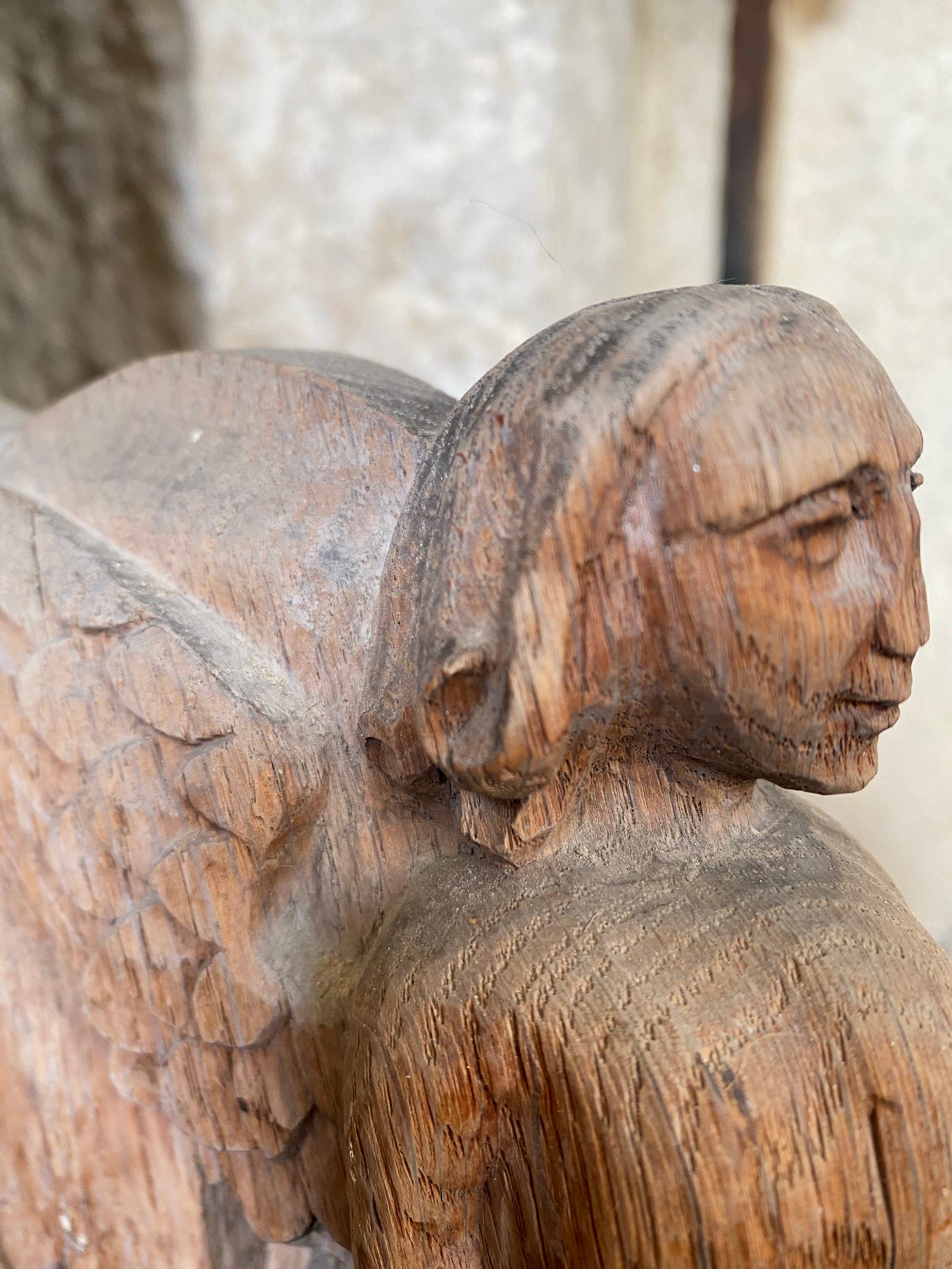

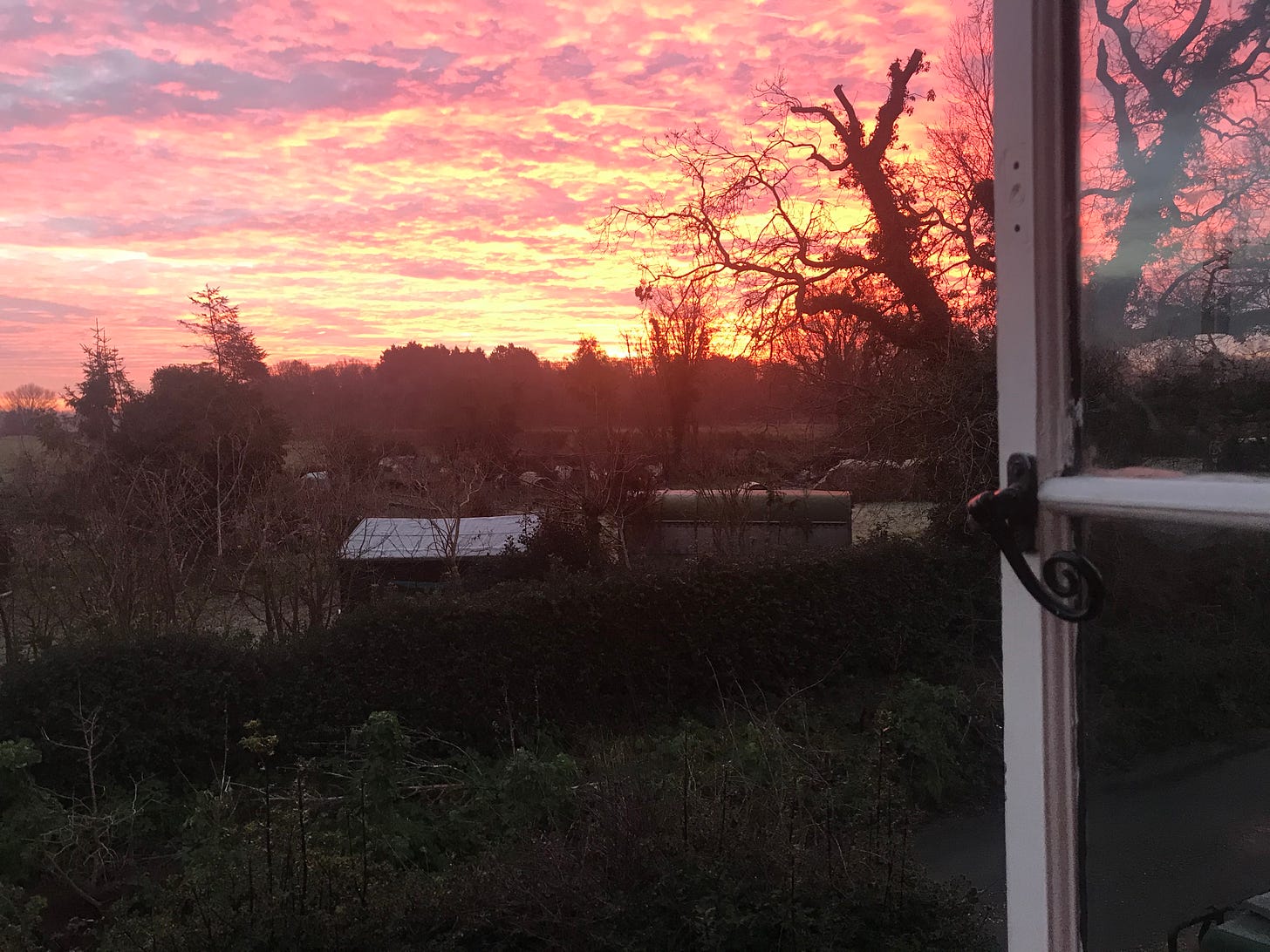


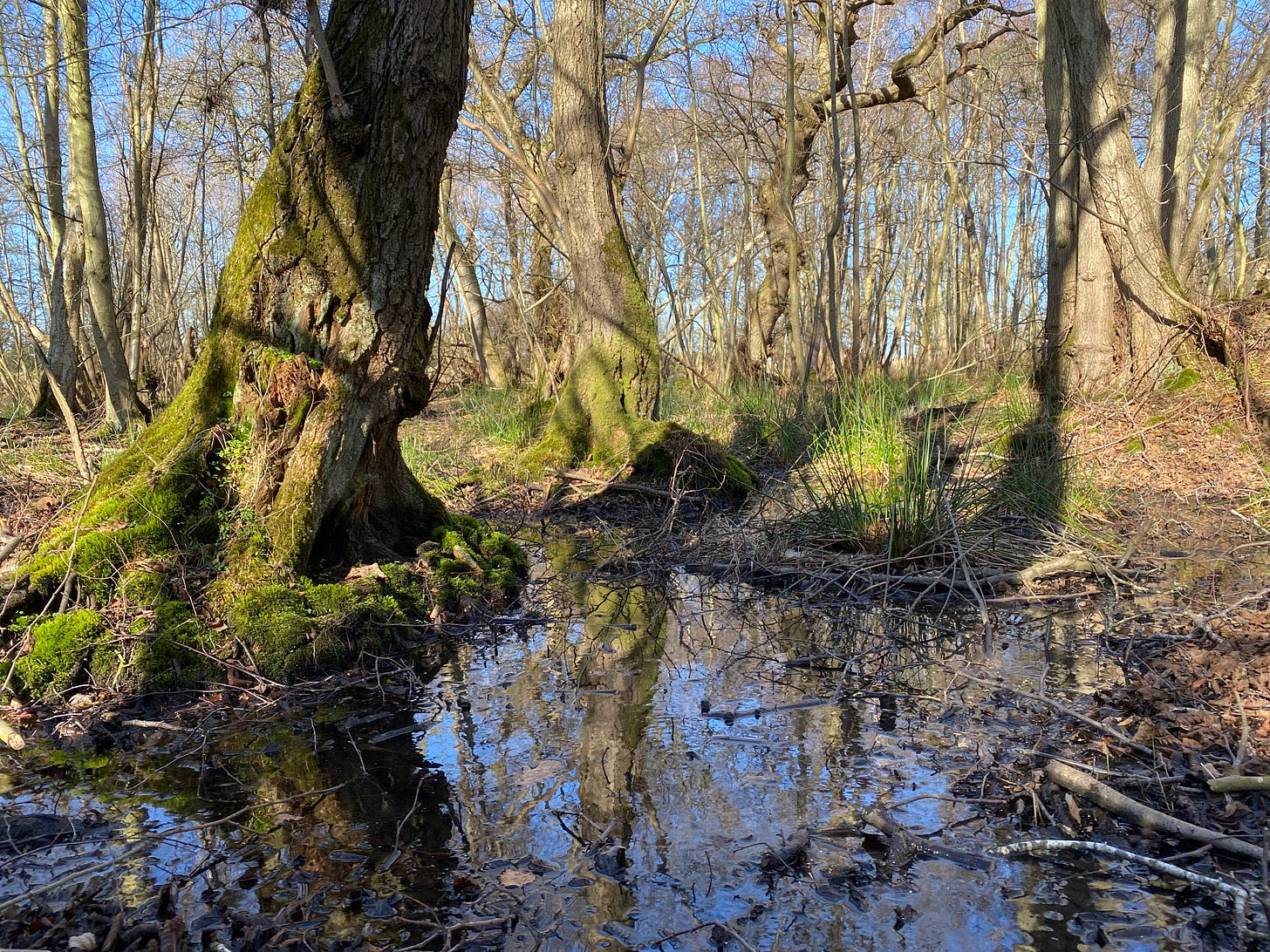



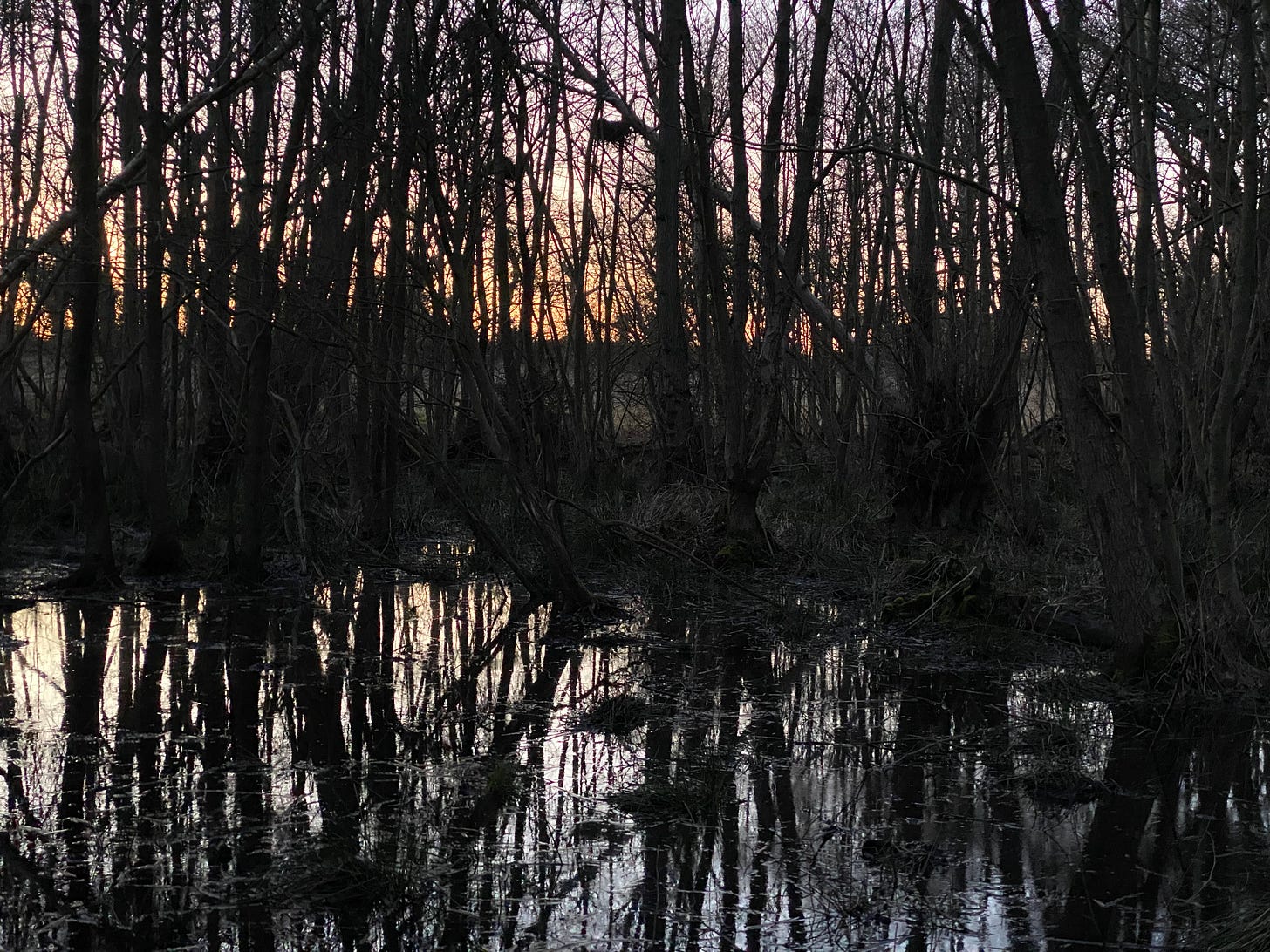
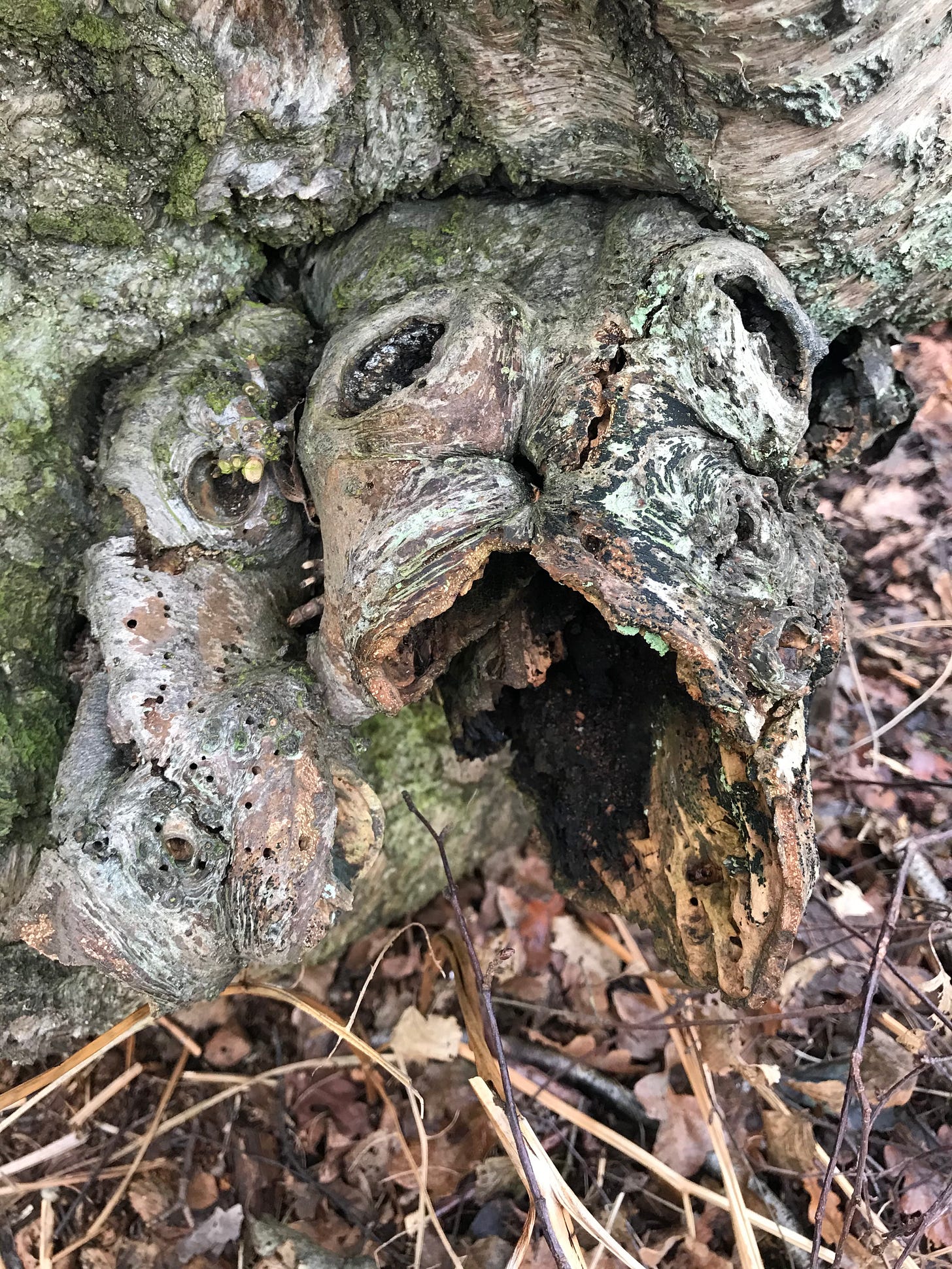

Thank you Imogen for such an interesting and nourishing read.
Thanks for inviting us along on your rambles, I love seeing where you tread and your connection to the land.